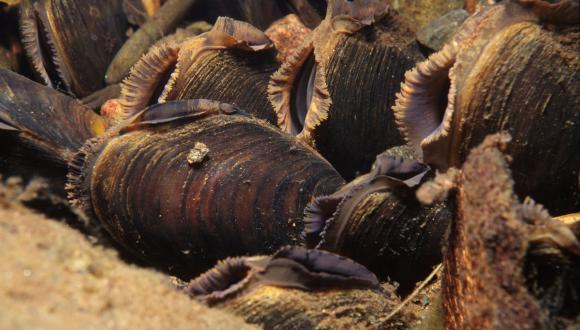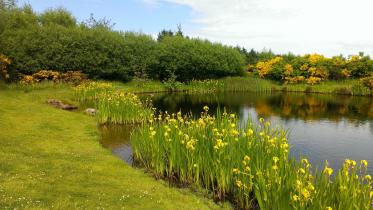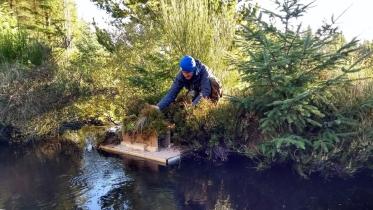Standing advice for planning consultations - Freshwater Pearl Mussels
This is standing advice to help planning applicants seeking permission for development that could affect freshwater pearl mussels, and to assist planning officers and other regulators in their assessment of these applications
This is standing advice to help planning applicants seeking permission for development that could affect freshwater pearl mussels, and to assist planning officers and other regulators in their assessment of these applications. It avoids the need for us to advise on individual planning consultations in relation to freshwater pearl mussels. We will only provide further advice in exceptional circumstances that are not covered by this standing advice.
Consideration of protected species in development management
Scottish Planning Policy requires that the presence (or potential presence) of legally protected species is factored into the planning and design of development proposals, and that any impacts on protected species are fully considered prior to the determination of planning applications.
Where impacts on a protected species cannot be avoided, certain activities may only be undertaken with a licence from NatureScot. It is important that any licensing issues are considered as part of a planning application to avoid any unnecessary delay to a development proceeding.
Legal protection for freshwater pearl mussels
Freshwater pearl mussels are protected by the Wildlife and Countryside Act 1981 (as amended) and by the Nature Conservation Act 2004. Offences relevant to development works include to intentionally or recklessly:
- kill, injure, take or disturb a freshwater pearl mussel;
- damage, destroy or obstruct access to a riverbed supporting freshwater pearl mussels;
This means that if freshwater pearl mussels could be affected in these ways by a development, and no action is taken to prevent it, an offence may be committed. The advice below will help ensure that impacts on freshwater pearl mussels are minimised and no offences occur.
Some of the most important freshwater pearl mussel populations are qualifying features of Special Areas of Conservation (SACs), and therefore receive further legal protection under the Habitats Regulations. We have published guidance specifically for considering projects that could affect two of these SACs, the River Tay SAC and River South Esk SAC. The guidance is applicable to other freshwater pearl mussel SACs, and more generally outwith SACs in terms of the potential impacts and how to avoid them. See the JNCC website for a full list of freshwater pearl mussel SACs.
When a development could affect freshwater pearl mussels
Freshwater pearl mussels inhabit coarse sand and gravel beds of fast-flowing, non-calcareous streams and rivers. They are dependent on the presence of trout or salmon to complete their life cycle. Mussel larvae released by adult females in summer need to attach themselves to the gills of young trout or salmon, where they live harmlessly before dropping off and settling on the river bed the following spring.
They are now extinct in most of the lowlands, and scarce everywhere except for a selection of Highland rivers, and a few in the southwest. Because of their rarity and the threat posed by illegal pearl fishing, the precise locations of freshwater pearl mussel populations are not made public. If the development proposal could potentially affect freshwater pearl mussels, you should contact the NatureScot licensing team.
Freshwater pearl mussels are filter feeders and so vulnerable to alterations to water levels and flows and impacts on water quality. They are can be affected by chemical pollutants entering the river or being smothered by the release of soil or other material into the river. Freshwater pearl mussels are particularly sensitive to any increase in phosphorus levels which feeds algal growth, blocking the spaces in the river gravels they rely on and reducing the amount of oxygen available to them.
A survey of freshwater pearl mussels should be undertaken if they could be present in a watercourse within or close to a development site and potentially affected in the ways described above.
Carrying out a freshwater pearl mussel survey
Surveys should be done by persons with the appropriate knowledge of freshwater pearl mussel ecology and practical experience of freshwater pearl mussel survey work. Safety procedures must be in place because of the potential dangers of working within fast flowing rivers. The surveys can only be undertaken in periods of low water flow, which usually means they are restricted to being carried out between April and September. They involve carefully and systematically walking stretches of river using a clear-bottomed bucket to look for mussels on the river bed. The extent of the survey required will depend on the nature of the development proposal. Details of survey requirements and procedures are provided in our Freshwater Pearl Mussel Survey Protocol. The survey methods involved can cause disturbance to freshwater pearl mussels and so will require a survey licence from NatureScot (see our website for further details).
The survey information needs to be sufficiently up-to-date when a planning application is submitted. Pre-application freshwater pearl mussel surveys normally remain valid for two more survey periods, and should be repeated if the application is going to be delayed beyond the start of a third survey period. Unless it is clearly evident that there has been no substantive change in number, distribution or activity of freshwater pearl mussels since the original survey was undertaken.
Reporting survey results
If a development proposal has needed a freshwater pearl mussel survey, a survey report must be submitted as part of the planning application. The report should include:
- names and experience of surveyors;
- details of any information gathered from Local Record Centres or other sources;
- descriptions of habitat surveyed and any limitations to the survey, such as access;
- survey methods, including survey area, date, time and weather conditions;
- survey results; the information required and how to present it in the survey report are described in our Freshwater Pearl Mussel Survey Protocol;
- an assessment of how the development might affect freshwater pearl mussels.
If freshwater pearl mussels could be affected by the proposal, the report must include a protection plan. The plan should include:
- measures proposed to minimise impacts on freshwater pearl mussels, including annotated maps and/or photographs showing the location of any measures proposed and how they relate to survey information and construction work;
- a summary of any residual impacts once the above measures are taken into account;
- details of any licensing requirements.
Measures to minimise impacts on freshwater pearl mussels
Measures to minimise impacts on freshwater pearl mussels should follow a hierarchy of avoidance and mitigation:
Avoidance
- Design the development and construction methods to avoid impacts on freshwater pearl mussels.
- Avoid crossing through any watercourses close to a freshwater pearl mussel bed, or, where unavoidable, constructing temporary bridges.
- Maintain natural water levels in areas occupied by freshwater pearl mussels.
Mitigation
- Manage site drainage using appropriately sized settlement ponds and/or silt traps to avoid direct entry into watercourses.
- Treat appropriately any discharge arising from the development.
- Create buffer strips along watercourses to exclude construction work or vehicle movements.
- Lay down protective matting across any damp ground likely to be churned up by vehicle movements, and avoid carrying out any works resulting in ground disturbance during or immediately following wet weather.
- Put sediment trapping barriers in place, such as bunds or dams, to prevent any sediment entering watercourses.
- Brush roads regularly to keep free of dust and mud.
- Store chemicals and fuels in a safe place.
- Minimise the amount of topsoil stripped or stockpiled at any one time.
Licensing development works affecting freshwater pearl mussels
Licences for development works that would otherwise result in an offence with respect to freshwater pearl mussels can only be issued if:
a) the development will give rise to significant social, economic or environmental benefit (see Protected Species Licensing: Licences for ‘social, economic or environmental purposes’) and
b) there is no other satisfactory solution.
Guidance on applying for a freshwater pearl mussel licence for development purposes, along with the application form can be found on our website. For further information on protected species licensing see Protected Species Licensing: Legislation, Appropriate Authorities and Licensing Purposes.
Contact
If you already have a licence number, include it in the subject line of your email, or have it to hand when you call.






